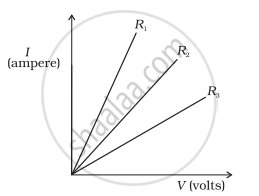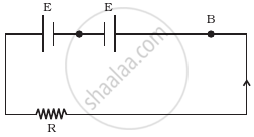Advertisements
Advertisements
प्रश्न
Calculate the electric field in a copper wire of cross-sectional area 2.0 mm2 carrying a current of 1 A.
The resistivity of copper = 1.7 × 10–8 Ω m
उत्तर
Given:-
Area of cross-section, A = 2 × 10–6 m2
Current through the wire, i = 1 A
Resistivity of copper, ρ = 1.7 × 10–8 Ωm
Resistance of a wire,
\[R = \rho\frac{l}{A}\]
Also from Ohm's Law, voltage across a wire,
\[V = iR = \frac{i\rho l}{A}\]
The electric field of the wire,
\[E = \frac{V}{l}\]
Now:
`R = (fl)/A`
`= (1.7xx10^(-8)xxl)/(2xx10^-6)`
`V = iR = (1 xx1.7xx10^-8xxl)/(2xx10^-6)`
`E = (dV)/(dL) = V/l`
`= (1.7xx10^-8)/(2xx10^-6`
`= 1.7/2xx10^-2`
`= 17xx10^-3`
`= 8.5xx10^-3`mv/m.
APPEARS IN
संबंधित प्रश्न
What will be the change in the current if the potential difference is kept constant and the resistance of the circuit is made four times?
- It will remain unchanged.
- It will become four times.
- It will become one-fourth.
- It will become half.
Is Ohm’s law universally applicable for all conducting elements? If not, give examples of elements which do not obey Ohm’s law.
What is Resistivity?
Write the formula of resistivity
An electrical bulb is marked 200V, 100W. Calculate the electrical resistance of its filament. If five such
bulbs are connected in series to a 200V supply, how much current will flow through them?
Name the law which is illustrated by the above V−I graph.
Fill in the following blank with suitable words:
Resistance is measured in .............. The resistance of a wire increases as the length ..............; as the temperature ..............; and as the cross-sectional area .............. .
How should the two resistances of 2 ohms each be connected so as to produce an equivalent resistance of 1 ohm?
The resistors R1, R2, R3 and R4 in the figure given below are all equal in value.

What would you expect the voltmeter A, B and C to read assuming that the connecting wires in the circuit have negligible resistance?
Calculate the current flowing through a wire of resistance 5 Ω connected to a battery of potential difference 3 V.
Tick(✓) the correct choice in the following:
Ohm's law is applicable to
Explain the equivalent resistance of a series resistor network.
A student carries out an experiment and plots the V-I graph of three samples of nichrome wire with resistances R1, R2 and R3 respectively. Which of the following is true?

A metal rod of length 10 cm and a rectangular cross-section of 1 cm × `1/2` cm is connected to a battery across opposite faces. The resistance will be ______.
Two cells of same emf E but internal resistance r1 and r2 are connected in series to an external resistor R (Figure). What should be the value of R so that the potential difference across the terminals of the first cell becomes zero.
Two conductors are made of the same material and have the same length. Conductor A is a solid wire of diameter 1 mm. Conductor B is a hollow tube of outer diameter 2 mm and inner diameter 1 mm. Find the ratio of resistance RA to RB.
What is the resistance of a conductor through which a current of 0.5 A flows when a potential difference of 2V is applied across its ends?
What is meant by resistance of a conductor ? Define its SI unit.

Vinita and Ahmed demonstrated a circuit that operates the two headlights and the two sidelights of a car, in their school exhibition. Based on their demonstrated circuit, answer the following questions.
- State what happens when switch A is connected to:
a) Position 2
b) Position 3 - Find the potential difference across each lamp when lit.
- Calculate the current.
a) in each 12 Ω lamp when lit.
b) In each 4 Ω lamp when lit.
OR - Show, with calculations, which type of lamp, 4.0 Ω or 12 Ω, has the higher power.
